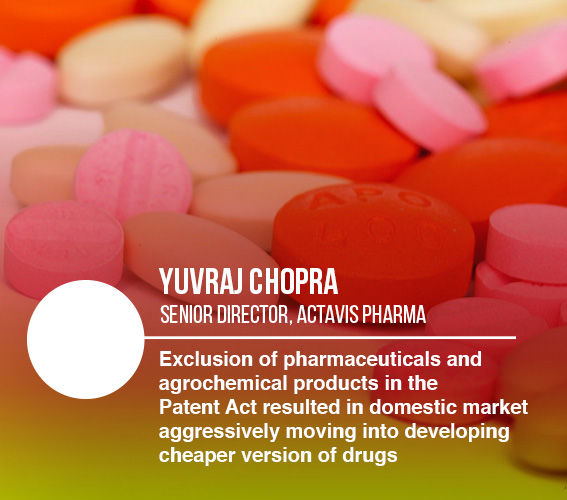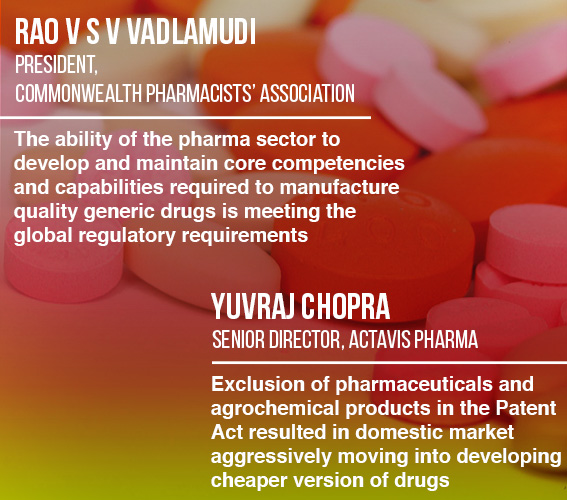The Indian Brand Equity Foundation (IBEF) states that the Indian pharmaceutical industry’s global share is 3.1 to 3.6 per cent; of all global generic pharma exports, 20 per cent is Indian; and the size of the country’s total production is worth $55 billion.
“Indian healthcare sector, one of the fastest growing sectors, is expected to advance at a CAGR (compounded annual growth rate) of 17 per cent to reach US$ 250 billion over 2008–20,” the IBEF study says. “The generics market stood at US$ 26.1 billion in 2016 from US$ 21 billion in 2015. India’s generics market has immense potential for growth,” it added.
The main drivers of the success of Indian pharmaceuticals story are patented products, consumer healthcare drugs, biologics, vaccines and the public health market. A McKinsey and Co. study marks these out as the latest growth areas. Add to that, immense potential of the generics market, and you have a situation that pharmaceuticals really began its journey in the 1970s as an area of manufacture, will reach the zenith that is now held by the slithering downward curve of information technology.
An industry insider, who did not wish to be named, said, “The patented product caters to only five per cent customers in the Indian market. You always have similar products available for the same therapeutic category and there efficacy is also good. Last year, the Indian pharma market witnessed growth of 2.4 per cent, where the total exports was USD 17 billion, while the size of the domestic market was USD 30 billion to USD 36 billion.”
Rao V S V Vadlamudi, the president of the Commonwealth Pharmacists’ Association, is also optimistic about the role generic drugs can play in the Indian pharmaceutical story. He says, “The ability of the pharma sector to develop and maintain core competencies and capabilities required to manufacture quality generic drugs is meeting the global regulatory requirements. The Indian pharma sector majors are developing a mindset to invest into research and development to meet the demands of global regulators.”

This unfolding story holds immense opportunities for the MSME sector. The MSMEs are the ones which dominate the generics market. Earlier, they had problems of the World Trade Organisation (WTO) instigated product patent regime called TRIPS (Agreement on Trade Related Intellectual Property Rights). Till 2005, India had a process patent regime. Though India signed TRIPS in 1994 and the agreement entered into force in 1995, New Delhi wanted to introduce the provisions in a graduated manner from 2005.
This yielded results. Yuvraj Chopra, a senior director at Actavis Pharma, says, “After India patent amendments, along with TRIPS and the General Agreement on Tariff and Trades (GATT), came into force, Indian companies dominated more in the market rather than importing the drugs. The reason is the exclusion of pharmaceuticals and agrochemical products, which resulted in a breakaway from the pattern of importing bulk drugs. Thus, domestic market aggressively moved into developing cheaper version of the drugs.”

Vadlamudi also feels that pharma MSMEs are poised to grow if they make smart moves. He adds, “There are many pharma players in the MSME sector which have stepped up and joined the big league. They can explore further opportunities by seeking membership of the Pharmaceuticals Export Promotion Council of India and look at global markets for growth. For the domestic generic market, these companies should be in a position to develop and manufacture quality products in a cost-effective way.”
The Central government took a decade to legislate the Indian Patents (Amendment) Act. And that was the entry point for product patents in a country that argued strongly in favour of a process patent regime that could avoid accrual of high cost of branded medicines.
At last count by the IBEF, in 2015, India has 10,500 manufacturing units and over 3,000 pharma companies. Most of these are obviously MSMEs. One cannot complete this paragraph without making an important point: the public sector healthcare is set to make a quantum leap at the rate of 16 per cent per annum. This has spread healthcare of reasonable quality to Tier II cities and even more rurban districts of the country. In other words, this has given a fillip to the pharmaceutical corporates, besides the generic drug manufacturers.
Many see public investment in the healthcare sector to do a huge pump priming by raising investment levels in the area by the Centre and state governments. As a concomitant, the desire for pharmaceutical industry can only rise in revenue as more and more of the population access healthcare.
In terms of export, Indian manufacturers of both generic and branded drugs have discovered the immense potential for revenue in the African continent. The journey had begun with Cipla beating the big pharma companies of the West hollow for providing solutions in the form of generic drugs to treat anti-retroviral disease.
However, there is still a long way to go for pharma SMEs to explore the foreign shores effectively. The industry insider pointed out the hurdles: “While the pharma SMEs are well recognised for the economic and social importance they have in the country, they are less focused on the exports. It requires them to compete globally and be innovative as well. The major hurdle for pharma SMEs to progress in this space is a lack of adequate funding. This needs to be changed, and there should be some regulatory compliance for this as well.”
A PricewaterhouseCoopers (PwC) report states the following:
“The Satwant Reddy committee’s report on data protection has recommended pro-patent amendments and data exclusivity for a period of five years. The enforcement regime is also changing, but the legal system is currently too overburdened for these improvements to be immediately effective.”
The pharma sector in India is a prime destination for foreign direct investment (FDI). The government is taking a more granular view of the issue. It has allowed 100 per cent FDI on the automatic route in making medical devices and 74 per cent in the basic pharmaceutical sector. A large number of Western pharma giants are finding virtue in outsourcing even more critical drug brands to India. Clearly, cost is a big motivator on the part of these corporations. The lower it goes the better is the maximisation of profits.
The PwC report suggests that following the model of the IT sector, the governments – Union and state – are creating infrastructure for the other growth industry – that is, biotechnology – in the healthcare sector. The governments are setting up technology parks on bioinformatics and biotechnology. The country, long a favourite for clinical trials, is attempting to create the legal and regulatory structure to have clinical trial hubs across the country. But, this is a time-consuming exercise: the laws related to having clinical trials have to be brought in line with international standards and regulatory framework has to be created to take clinical trial process out of its often nefarious reputation into the light of statutory sanctions that help it to lose its current cloak-and-dagger phenomenon.
Finally, it has to be said that the TRIPS was signed in line with the country’s serially infamous economic liberalisation programme, it has helped to create islands of excellence. But, for a more holistic development of the sector, the state needs to do more to create a milieu that is complementary to the liberal practices of reforming the healthcare sector – often usurious in the hands of the private operators. And, there is a need for introducing innovation is imperative that could generate a quantum leap, which could make the pharmaceutical an engine of economic growth in the conventional sense.
(With inputs from Anushruti Singh)











